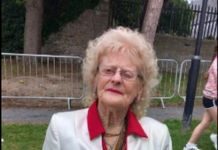by Alan Jacques

London-based Claire Carmody-Portier, originally from Caherdavin Lawn, worked as a volunteer in July and October on the installation at the Tower of London to mark the centenary of the start of the First World War.
Each flower represents a British military fatality during World War One and the display has been visited by almost four million people so far this year.
Claire, who works as global audit director for treasury at Barclays Bank, said it was fantastic to be involved in such a beautiful commemoration for the fallen of WWI.
The mother of twin 5-year-old boys has retained a passionate interest in all things relating to the First World War since her secondary school days in Salesians Secondary School in Fernbank.
“Three of my granduncles fought in World War One, though thankfully they all survived. My husband’s granduncle was killed at the Battle of Verdun, which had a huge impact on his family at the time.”
“We all think of World War One now as a terrible waste of life on a such colossal scale. So this was a tremendous opportunity to be a part of something which would in some small way remember their courage and sacrifice,” the 43-year-old Limerick woman says.
The installation titled ‘Blood Swept Lands and Seas of Red’ by ceramic artist Paul Cummins is due to be dismantled this week after Armistice Day. However, it has captured people’s imagination to such an extent that there has been calls for it to be extended, with thousands of people having already signed an e-petition calling for the poppies to remain.
“People have come from all over the world,” said Claire.

“When I got involved I knew the Commonwealth War Graves Commission were involved and that it would include the Irish men also who had fought in the First World War and had never come home. For so long they have remained forgotten and here was an opportunity to remember them,” she adds.
The poppy stands were made using steel rods and washers with the ceramic heads added at the end. The steel rods alone weigh 90 tonnes, and Claire believes this drives home both the scale of the project but also what it represents in terms of the loss of human life.
“The volunteers I worked with during both plantings came from all over the world, each there for their own special reason. When I planted in August, I was paired with a girl from East Germany who was also living in London. It shows how far we have come from those dark years of 1914-1918.”
“Those who come to pay their respects and admire the beauty of this commemoration are also remembering the Irishmen who made the ultimate sacrifice. I feel we have, in some very small way, done them proud,” Claire concludes.









